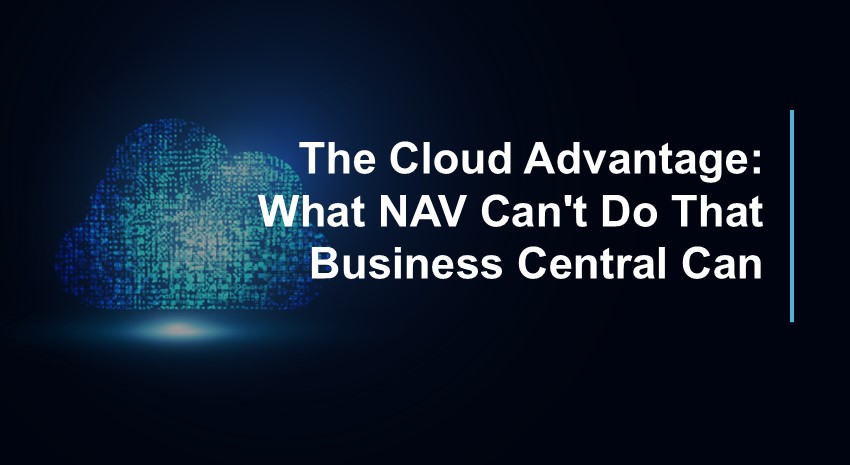What Dynamics NAV Can't Do That Business Central Can

For many organizations, Microsoft Dynamics NAV has been a reliable workhorse for years, effectively managing their accounting, inventory, and operations. But, as great as it might be, the reality is that Dynamics NAV was built for a different era. As businesses have grown more digital, collaborative, and cloud-centric, NAV’s limitations are becoming more obvious.
Microsoft Dynamics 365 Business Central builds on NAV’s foundation, adding modern functionality, integration, and scalability that today’s businesses need. If your company is still running NAV, here are 10 areas where Business Central leaves NAV behind and why it might be time to make the move to Business Central.
Cloud-native flexibility
Dynamics NAV is a traditional on-premises system that requires servers, IT maintenance, and manual updates. While some companies have moved their NAV systems to hosted virtual machines (VMs) on Azure, this setup is more of a workaround than a true solution. It often leads to performance issues, complex maintenance, and higher costs, because you’re still running an aging system in a hosted environment rather than a platform built for the cloud.
Business Central, by contrast, is cloud-native, with no need for manual updates, no infrastructure to manage, and seamless scalability.
Seamless integration with Microsoft 365
NAV’s integration with Microsoft tools is limited and often requires custom development or the use of third-party connectors. On the other hand, Business Central provides deep, native integration across the Microsoft ecosystem:
- Outlook: Create quotes and invoices directly from your inbox.
- Teams: Share real-time financial data in meetings and chats.
- Excel: View, edit, and refresh ERP data directly within spreadsheets.
This unified experience improves collaboration and reduces manual data entry errors.
AI and Copilot capabilities
NAV doesn’t have any built-in artificial intelligence or machine learning capabilities. Business Central introduces Microsoft Copilot and AI-driven features that transform how teams work by:
- Suggesting account codes for journal entries.
- Automating bank reconciliations and repetitive tasks.
- Providing predictive insights for cash flow, inventory, and sales.
These features empower teams to move from manual, reactive processes to proactive, insight-driven decision-making.
Advanced reporting and analytics using the Power Platform
NAV’s reporting functionality, while serviceable, is limited and often requires complex customization or third-party add-ons.
Microsoft’s Power Platform is a suite of software tools that adds reporting, automation, AI capabilities, and more to Business Central.
Business Central integrates natively with Power BI, enabling the creation of dynamic, interactive dashboards and real-time analytics that drive better decisions. Executives and managers can track KPIs, drill down into details, and share insights with ease — no manual exports or static reports required.
Regular, automatic updates
Dynamics NAV users know the pain of upgrades – they’re expensive, time-consuming, and disruptive. Many companies skip versions, creating a widening technology gap that makes future upgrades even harder.
Business Central addresses this issue with automatic, twice-yearly updates, as well as incremental improvements made throughout the year. Your system stays current, secure, and aligned with Microsoft’s innovation roadmap — with minimal downtime or manual intervention.
Mobile-first access
NAV was built for desktop environments, and even with remote access tools and hosted environments, the experience is far from seamless. Business Central is mobile-ready out of the box, with native apps for iOS and Android that let users work anywhere, anytime – from the warehouse floor to a client site.
For companies with distributed teams or field operations, this kind of mobility drives efficiency and responsiveness.
ISV and add-on support
The ecosystem of Independent Software Vendors (ISVs) that built add-on products for NAV is shrinking. Many ISVs have shifted their development and support entirely to Business Central, meaning that critical apps developed for NAV may no longer be updated or supported.
This creates risk: You’re running key business functions on outdated extensions with no guarantee of future compatibility or security. In Business Central, the AppSource marketplace offers a wide range of supported, cloud-ready extensions that evolve in tandem with the platform.
In fact, you might find that some solutions that were only available through an ISV product for Dynamics NAV are now a native part of Business Central, eliminating the need for third-party products.
Scalability for growth
NAV often struggles to keep up with growth or complex operations. Business Central scales effortlessly, handling multi-entity, multi-currency, and multi-language environments, all within a unified, cloud-based platform.
As your organization expands, you won’t hit a ceiling or need to replatform; Business Central can grow with you.
Built-in compliance and security
In Dynamics NAV, the burden of compliance and security falls on your IT team. This means managing patches, backups, and regulatory requirements manually, which can be a costly and high-risk proposition.
Business Central, hosted in Microsoft Azure, offers enterprise-grade security and built-in compliance with GDPR, ISO, SOC, and other key standards. Automatic backups, data encryption, and redundancy are built into the platform, providing you with peace of mind without additional overhead.
Lower total cost of ownership
On the surface, sticking with Dynamics NAV may seem cost-effective, but the hidden costs add up: adding new hardware, maintenance, manual upgrades, limited support, and technical workarounds like hosted VMs. Additionally, there are the costs associated with renewing your software licenses and maintenance agreements for NAV and any ISV products you are using.
With Business Central’s subscription model, you eliminate many of those costs while gaining access to continuous innovation, advanced functionality, and simplified IT management, all of which contribute to a lower Total Cost of Ownership (TCO).
Making the move
Upgrading from NAV to Business Central isn’t about abandoning what works; it’s about ensuring your ERP platform evolves with your business.
The longer you wait, the greater the gap between your current system and modern capabilities — and the more opportunities you risk missing.
Moving to Business Central now will position your organization for efficiency, innovation, and growth. Contact ArcherPoint by Cherry Bekaert and discover that the transition from NAV to Business Central can be smoother and faster than you might expect.
Trending Posts
Stay Informed
Choose Your Preferences
"*required" indicates required fields

